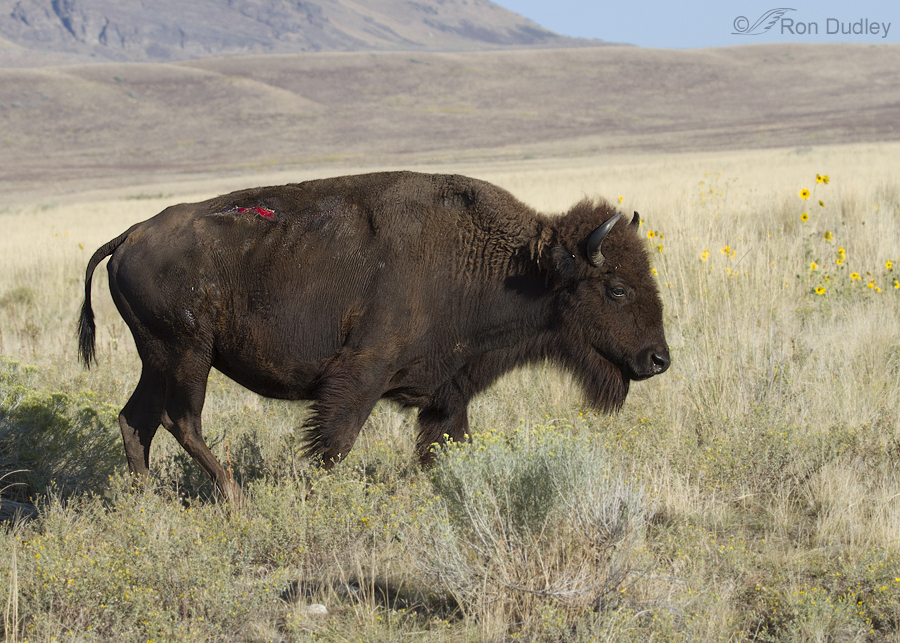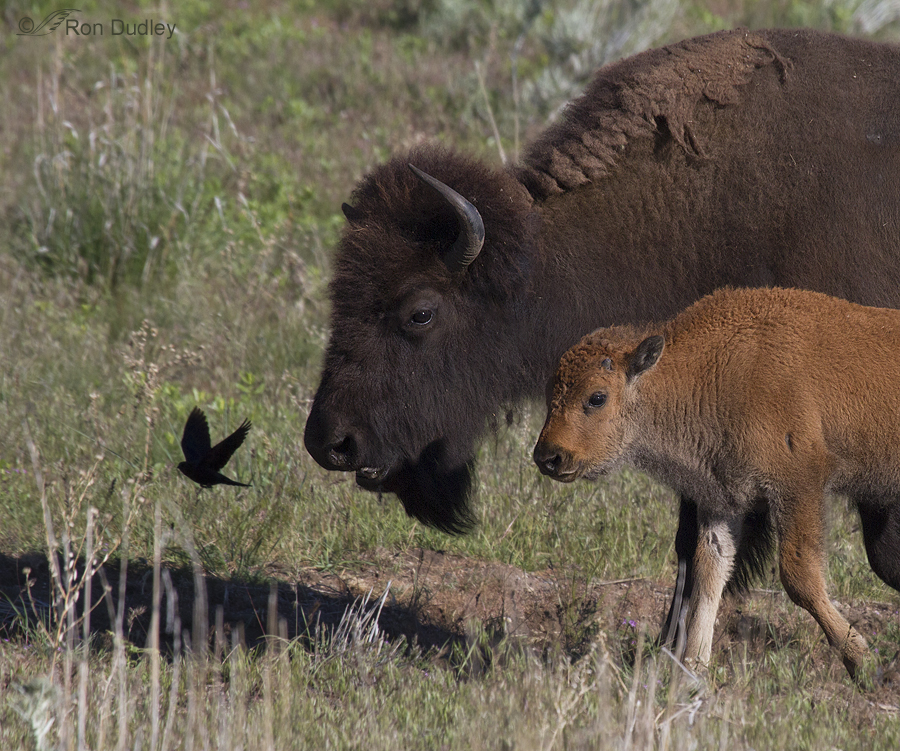Tag: bison
A Serendipitous “Buffalo Bird” And A Bison Cow And Calf
The Bison Of Antelope Island
Last fall I drove up just as this scenario was playing out. This guy was a biker (bicycle) who had laid his bike down on the road and approached this bison much too closely on foot to get a few photos with his point and shoot. I just knew bad stuff was going to happen so I quickly aimed my camera just as the bison charged this bozo.
Mucus-drinking Cowbird
Before Europeans came to North America and cleared forests which modified the environment into the agricultural and suburban landscapes of today, the range of the Brown-headed Cowbird was limited to the short-grass plains where they followed the almost endless herds of American Bison as they fed on the insects stirred up by those wandering behemoths. Early settlers so strongly associated them with bison that they were called “Buffalo Birds”. Today that relationship still exists wherever limited numbers of bison can still be found. Antelope Island is one of those places. One of the many challenges facing the cowbird was obtaining enough moisture as it followed the bison herds over the hot, rolling plains. In late summer several years ago I photographed a cowbird behavior that illustrated one of the ways they solved that problem. I found this huge bull languishing in the broiling sun next to a boulder that it had been using as a scratching post. A group of Brown-headed Cowbirds were in the vicinity but at first I wasn’t paying much attention to them. Then this female (at frame bottom) flew in close… and began flying at the nostrils of the bull. Initially I was unsure about what she was doing but she did it repeatedly and eventually it became clear that she was… drinking the mucus-laden secretions from the bison’s nostrils. She would actually hover in place as she gobbled down the long, stringy strands of mucus. Not a pretty sight and perhaps a bit unsettling to our human sensibilities but what an incredibly adaptive behavior…
Another Act Of Idiocy On Antelope Island
Yesterday, while showing some out-of-town friends around Antelope Island, we came upon this cyclist who had left his bike on the road and walked up to within a few feet of this bison in order to photograph it. At first he was much closer to the animal than you see here but when the bison began to show signs of irritation the cyclist backed off a few feet and continued to take photos. I stopped my vehicle and grabbed my “other” camera because I figured that something unpleasant might go down but in the excitement I bumped the control wheel on the camera and skewed my settings so the resulting photos are of poor quality and for documentation only. I’ve disguised the face of the cyclist. Before I could get off any shots of the cyclist photographing the bison the massive animal charged. This guys reactions were pretty quick. Here the cyclist doesn’t yet know that the bison’s charge was apparently a bluff… but he does now. This guy didn’t even have a vehicle to run to for protection – only his bike. And incredibly, after the charge, he turned around and approached the bison again. This kind of stupidity puts both humans and animals at risk. If the cyclist had been killed or injured I suspect the bison would have been destroyed. Similar unthinking behaviors from island visitors occur regularly on the island as I’ve documented before. The “Darwin Awards” in action… Ron
The Timelessness of a Buffalo Chip Perch
The American Bison is a relative newcomer to North America, having migrated from Eurasia over the Bering Straight about 10,000 years ago. As is common knowledge they once roamed in massive herds across most of the continent until commercial hunting and slaughter reduced their numbers to a few hundred by the end of the 19th century. 1/500, f/6.3, ISO 500, 500 f/4, 1.4 tc Today a herd of approximately 500 animals roams free on Antelope Island and that many large animals produce a lot of poop – commonly referred to as “buffalo chips”. Those chips are all over the island – like small dark islands in a sea of prairie grasses and tiny flowers and they’re tempting perches for a variety of bird species like Horned Larks and Meadowlarks. But this past week I was able to catch some larger birds using them as perches. 1/2000, f/6.3, ISO 500, 500 f/4, 1.4 tc In the spring some of the shorebirds and wading birds come up from the shore of the Great Salt Lake to higher ground on the island for their breeding activities – Long-billed Curlews among them. It seems that the added height of only a couple of inches provided by the chip is enough to significantly improve their view of the landscape for potential predators and also to help them keep an eye on other curlews in the area – there’s a lot of fighting and mating activities going on this time of year. To some viewers such a perch may have no aesthetic draw but I’m…
Behaving Badly On Antelope Island
Mia and I spend an inordinate amount of time on Antelope Island photographing birds so naturally we run across a lot of other folks out there enjoying that wonderful place too – hikers, photographers, campers, swimmers, educational groups and everyday sightseers to name a few. Most of the people who visit the island seem to be considerate of others and mindful of the regulations in place that are meant to make a visit to the island an enjoyable experience for all and protect the natural assets of this jewel in the middle of the Great Salt Lake. There are glaring exceptions though and occasionally (all too often) we see folks doing things that leave us shaking our heads in bewilderment. I decided to post about this issue in the hope that it might be a reminder to some of the “fringe element” who may be considering a visit to the island that if you flaunt the rules you may pay a price. Where recognizable, faces have been blurred in these photos. If the image file numbers (seen by passing your cursor over the photo) don’t seem to make logical, sequential sense it’s because I used multiple cameras and lenses for the images. Last Friday morning as we left Bridger Bay Campground we noticed that this guy in a Jeep had decided to go for a cross-country joy ride across the prairie grasses to get a closer look at a couple of bison, despite the fact that they’re nearly always easy to find right next to the road. In the foreground you can see the…
Early Spring Birds and Craziness on Antelope Island
Typically our first spring camping trip is a shake-down cruise for the trailer to Antelope Island. If anything goes wrong with the trailer (and it sometimes does after sitting all winter) I’ll be relatively close to home. This year we spent the last two days of March on the island. Most of the photos in this post were taken on that trip. 1/2500, f/6.3, ISO 500 There’s been a few Western Meadowlarks on the island for much of the winter but they’ve returned in large numbers now. In all my travels in the west I don’t think I’ve ever seen any other area with such a high concentration of this species. At times their beautiful song resonates all over the hills of the island. Meadowlarks always bring back fond memories for me of growing up on the Montana farm. 1/2500, f/6.3, ISO 500 Loggerhead Shrikes are another very common species, especially on the northern part of the island. They’ve been absent all winter but we’re seeing more of them on each visit now. It was cloudy when this image was taken and I didn’t get a lot of light in the eye but I think there’s just enough. 1/2500, f/7.1, ISO 500 I always look forward to the return of the Long-billed Curlews with great anticipation and they started appearing about 10 days ago. I was happy to get this shot of the male on the right displaying for the female. Male and female curlews are almost identical but they can be differentiated by their…
Antelope Island
Of the eight major islands in the Great Salt Lake, Antelope Island is the largest at 15 miles long and 4.5 miles wide. Frary Peak reaches an elevation of 6596 feet. The island has an intriguing history, interesting geology and free roaming herds of bison, bighorn sheep, mule deer and pronghorn, in addition to a variety of smaller mammal species and plentiful birds. It is one of my very favorite photography locations – especially for birds. In this blog post I will present an overview of the island and some of its wildlife. My next post will deal specifically with bird photography on the island. The north end of Antelope Island at sunrise as seen from the causeway access road There is a 7 mile long causeway road that provides the only access to the island, which is actually a peninsula when the Great Salt Lake water levels are low. It’s common to see a variety of wildlife along this causeway including coyotes sprinting at the first sight of an early morning vehicle, American Kestrels, Northern Harriers, Burrowing Owls, Common Ravens and a variety of waterfowl and shorebirds where the water comes closer to the causeway. Approaching the north end of Antelope Island As you get closer to the island the water comes right up to the causeway’s edge and typically there’s hordes of waterfowl and shorebirds very close to the road. In the photo above, several shoreline levels of ancient Lake Bonneville can be seen where wave action eroded “benches” in the sides of the…



